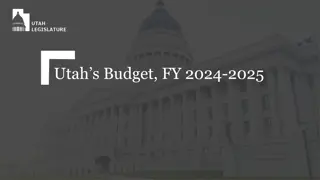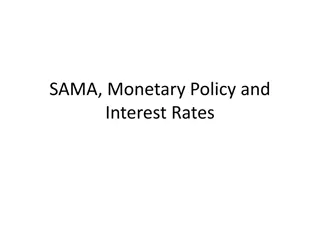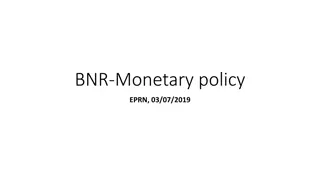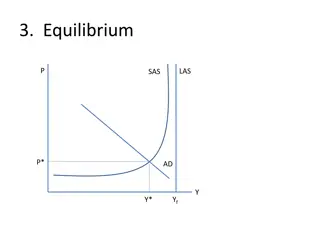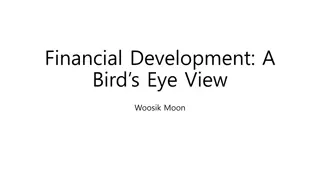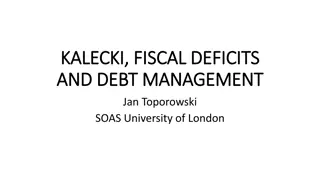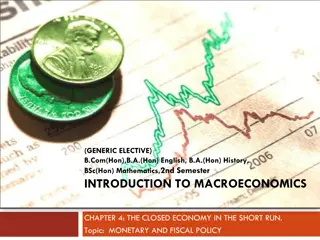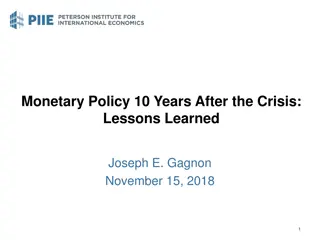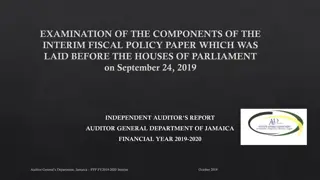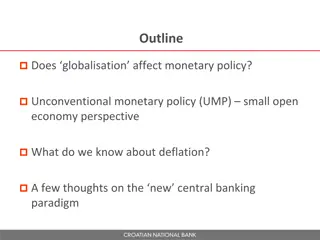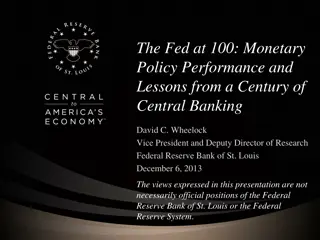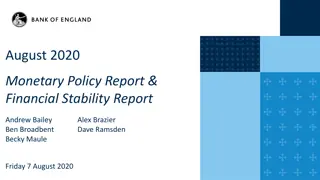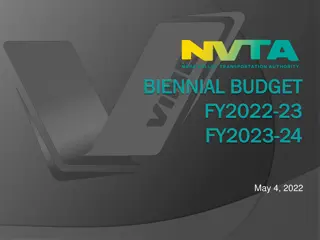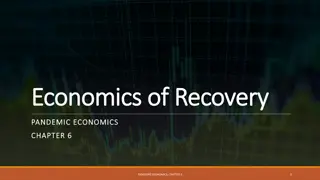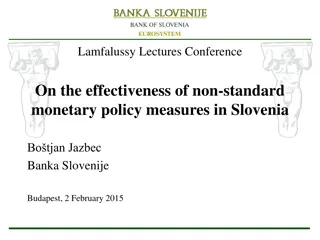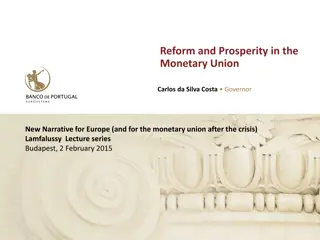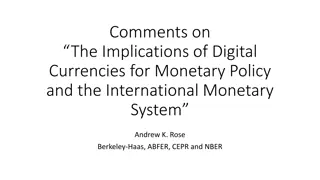Economic Recovery and Fiscal Stability in Uruguay: Budget Law and Monetary Policy Framework 2020-2024
The Budget Law and Monetary Policy Framework in Uruguay for 2020-2024 focus on restoring fiscal consolidation, stabilizing debt, and implementing market-friendly policies for economic recovery. Successful COVID-19 containment strategies have allowed for a faster normalization of economic activity. Leading indicators show signs of economic recovery, reflected in fiscal revenues and automatic stabilizers.
Download Presentation

Please find below an Image/Link to download the presentation.
The content on the website is provided AS IS for your information and personal use only. It may not be sold, licensed, or shared on other websites without obtaining consent from the author.If you encounter any issues during the download, it is possible that the publisher has removed the file from their server.
You are allowed to download the files provided on this website for personal or commercial use, subject to the condition that they are used lawfully. All files are the property of their respective owners.
The content on the website is provided AS IS for your information and personal use only. It may not be sold, licensed, or shared on other websites without obtaining consent from the author.
E N D
Presentation Transcript
Repblica Oriental del Uruguay 2020 2024 Budget Law and the new Monetary Policy Framework Mrs. Azucena Arbeleche Minister of Economy and Finance Mr. Diego Labat Governor of the Central Bank September 2020
KEY HIGHLIGHTS: MINISTRY OF FINANCE Priority is to restore fiscal consolidation and stabilize the government`s debt burden under realistic revenue projections. Commitment to meeting fiscal targets is anchored in a new fiscal framework and an austere 5-year budget law based on expenditure restraint. Skillful public health response to the Covid-19 crisis has limited virus spread and allowed a faster re-normalization of economic activity, tempering fiscal slippages. Despite forward with an ambitious agenda of fiscal and structural reforms through market- friendly policies to boost output and employment. Consistency between fiscal discipline, disinflation strategy and wage policies based on close coordination on policy-making. the Covid-19 outbreak, the Government moved 2
Successful containment strategy has limited virus spread, keeping the death toll subdued Covid 19-related deaths per million population (As of September 9th, 2020) Rate of spread of infection (As of September 9th, 2020) 7 1,000 6 800 5 N of infected Log scale (base 10) 600 4 400 3 Uruguay 2 200 1 0 4/6/2020 5/3/2020 6/7/2020 7/4/2020 8/9/2020 9/5/2020 3/10/2020 3/19/2020 3/28/2020 4/15/2020 4/24/2020 5/12/2020 5/21/2020 5/30/2020 6/16/2020 6/25/2020 7/13/2020 7/22/2020 7/31/2020 8/18/2020 8/27/2020 0 0 9 18 27 36 45 54 63 72 81 90 99 108 117 126 135 144 153 162 171 180 189 Uruguay Days since first confirmed case 3 Source: Johns Hopkins University; Our World in Data
Leading indicators suggest that the economic downdraft has bottomed- out, and a gradual recovery is underway Fuel demand (Rolling 7-day average, YoY change in %) Car sales in 2020 YoY change, in % Number of cars sold 40 4,000 10 First Covid-19 cases confirmed on March 13, 2020 0 20 3,000 -10 0 -20 -20 2,000 -30 -40 -40 1,000 -50 -60 -60 -80 17-Mar 25-Mar 1-Mar 9-Mar 5-Jun 13-Jun 21-Jun 29-Jun 2-Apr 7-Jul 8-Aug 16-Aug 24-Aug 10-Apr 18-Apr 26-Apr 15-Jul 23-Jul 31-Jul 4-May 12-May 20-May 28-May 0 -70 Jan Feb Mar Apr May Jun Jul Aug 31-Aug 4 Source: Ministry of Economy and Finance
which is reflected in fiscal revenues and automatic stabilizers Tax revenue collection (YoY real change, in %) Unemployment insurance (Number of beneficiaries by type of regime, in thousand workers) 10 Traditional Partial Thousands 200 5 0 150 -0.6% -5 100 -10 50 -15 -20 0 May-19 May-20 Apr-19 Aug-19 Nov-19 Apr-20 Feb-19 Jul-19 Sep-19 Feb-20 Jul-20 Mar-19 Jun-19 Dec-19 Mar-20 Jun-20 Jan-19 Oct-19 Jan-20 Aug-20 Aug-20 Jan-20 Feb-20 Mar-20 Apr-20 May-20 Jun-20 Jul-20 5 Source: Tax Collection Agency, Social Insurance Bank
Fully transparent fiscal registration COVID-19 Solidarity Fund. Created by Law (voted unanimously by all parties), to be managed by the Executive branch. The Fund clearly earmarks the budgetary resources to address the emergency, keeping tabs of the Covid-related expenditures and where and how the money is spent. Transparent registration of fiscal statistics. Frequent, timely and comprehensive disclosure of loan guarantees and contingent liabilities, allowing ex-post evaluation and accountability review. 6
Throughout the Covid-19 crisis, Uruguay has remained a bastion of institutional and political stability in Latin America Highest adherence to the rule of law 3/ Strongest political stability and full democracy 1/ 2/ 100 0.8 Full Democracies 80 0.6 60 0.4 40 0.2 20 0 0 URU CHL PAN ARG ECU PRY BOL PER BRA MEX COL URY CHL ARG PAN BRA COL PER ECU MEX BOL Lowest civil unrest 4/ Lowest corruption perception 5/ 10 80 8 60 6 40 4 20 2 0 0 CHL MEX COL PRY ECU PER BRA ARG PAN URY PAR MEX BOL BRA PAN PER COL ECU ARG CHL URY 7 Sources: 1/ Worldwide Governance Indicators, World Bank (2019); 2/ The Economist Intelligence Unit (2020); 3/ World Justice Project (2020); 4/ Verisk Maplecroft (first quarter of 2020); Transparency International (2020)
Backdrop before Covid-19 outbreak: decelerating economy, weak labour market, persistent fiscal deterioration and increasing debt burden Real gross fixed capital investment Real GDP (Annual change, in %) (Annual change, in %) 30 8 20 6 10 4 0.2 0 2 0 -10 -2 -20 -1.4 (*) YoY (*) YoY Central Government fiscal balance 1/ Central Government debt (12-month period, in % of GDP) (In % of GDP, end of period) Primary Balance Interests Overall Balance Gross Debt 80 Net Debt 0 60 49.6 -2 40 -4.8 -4 54.4 -6 20 2015 2016 2017 2018 2019 Mar-20 0 1/ Does not Include inflows of funds to the Social Security Trust. 2005 2007 2009 2011 2013 2015 2017 2018 2019 2020Q1 8 Sources: Central Bank of Uruguay; Ministry of Economy and Finance of Uruguay
The government is forging ahead with an ambitious reform agenda backed by political majority in Congress Key Milestones and Timing of Political Process Urgent Consideration Law Accountability Law: Fiscal Performance Report for 2019 2020-2024 Budget Law Submitted to Congress on April 23rd Submitted to Congress on August 31st Submitted to Congress on June 30th Congress approved it on July 8th 120-day discussion (approx.) Congress approved it on August 12th, 2020 9
New 5-Year Budget Law 2020-2024 sets out a credible medium-term fiscal consolidation plan and institutionalizes fiscal prudence Lays the foundations for significant changes on fiscal policy decision-making and rationale of budget preparation, with medium-term fiscal savings: 1. New fiscal framework to foster counter-cyclicality over the business cycle and sustainable finances over the medium term. 1. Zero-base budget strategy that reviews and reallocates existing spending, replacing incremental budgeting approach. 1. Austerity measures based on more efficient discretionary spending, restrictions on public sector hiring and spending oversight and auditing. 1. New governance policies, performance targets and accountability requirements for public enterprises. In addition, the Law of Urgent Consideration creates a Commission of experts to make proposals by mid-2021 for a comprehensive pension reform. 10
Material improvement in public finances relies on reducing primary expenditures as a percent of GDP, given the already elevated tax burden Central Government Balance: budget projections 1/ (In % of GDP) Central Government Fiscal Balance1/ (In % of GDP) 0 0 -1 -1 -2 -2 -2.7 -3 -3 -3.2 -3.6 -4 -3.8 -4 -5 -5 -6 COVID EFFECT 2/: -1,3% -6 -6.6 -7 -7 2014 2015 2016 2017 2018 2019 2020* (*) Projections (*) Projection 1/ Excluding Social Security Fund Fiscal Effect 2/ Above the line (fiscal) effect, i.e. expenditures minus extraordindary revenues as per established in the Covid-19 Solidarity Fund law. 11 Source: Ministry of Economy and Finance
..to stabilize debt burden under realistic revenue assumptions CG Gross and Net Debt to GDP Ratio (In %) 70 67.5 Gross Debt 63.9 65 Net Debt 60 55 53.3 49.5 50 45 2019 2020* 2021* 2022* 2023* 2024* Debt Sutainability Analysis Outcome 2019 2020* 2021* 2022* 2023* 2024* Gross Debt (in % of GDP) 53.3 65.6 65.7 67.7 67.6 67.5 Net Debt (in % of GDP) 49.5 60.6 61.7 64.0 63.8 63.9 Foreign Currency Debt (in % of total) 56.1 56.7 54.8 52.8 51.7 49.9 Effective Interest Rate (annual, in %)1/ 5.2 4.7 4.5 4.4 4.2 4.2 1/ Total annual interest payments as a share of year-end debt stock of last year. (*) Projections. 12 Source: Debt Management Unit, Ministry of Economy and Finance
New Fiscal Framework: Key features 1. Fiscal rule: o Structural balance targets, to account for business cycle fluctuations and one- off/temporary spending and revenue items. o Cap on real growth in primary expenditure in line with potential real economic growth (estimated currently at 2,3% annually). o New debt authorization framework sets a binding level of annual net indebtedness. 2. Independent fiscal councils: o Committee of experts to provide estimates of capital growth, labor and factor productivity. o Advisory fiscal council will provide estimates of GDP growth potential and structurally-adjusted fiscal numbers. 3.Transparency and communication:The Government will communicate, semi-annually, the government's overall assessment of the fiscal situation. 4. Medium-term budget forecasts:Macroeconomic projections will be provided over a rolling five-year period, thereby providing an outlook beyond the current administration. 13
Fiscal Rule: Structural Balance and Spending Cap Central Government Structural Balance (In % of GDP) Central Government Primary Expenditures (YoY real change, in %) Adjustment for Cyclical Factors 8 Extraordinary Factors Adjustment CG - BPS Balance 6 Structural CG - BPS Balance 2 4 Expenditure Cap by Law 0 2 0 -2 -2.5 -2 -4 -4 -6 -6 2019 2020* 2021* 2022* 2023* 2024* 14 (*) Projections Source: Ministry of Economy and Finance
Fiscal Rule: a new legal framework that limits Central Government indebtedness, tied to observed fiscal deficit The proposed framework establishes a limit to the Central Government Net Indebtedness, defined as gross debt issuance (bonds and loans) excluding amortizations and the variation in financial assets. This measure is equivalent to the fiscal deficit (up to mostly valuation effects). The new limit is USD 3.5bn for 2020 and USD 2.3bn for 2021. An escape clause allows for an additional 30% indebtedness, but only under restrictive circumstances and overseen by the Fiscal Council. 15
Consistent set of macroeconomic policies: fiscal targets, inflation targets and wage-setting guidelines Fiscal consolidation plans are consistent with: Central Bank s commitment to lower inflation and breaking inflation inertia, and 1) 1) New wage-setting guidelines for the private sector that reduce backward indexation and prioritize employment creation. 16
Growth agenda: the private sector should lead the way of the cyclical recovery and underpin medium-term growth prospects Largest-ever private investment in the country proceeding as scheduled: Uruguay poised to receive large FDI inflows. Aside from UPM, the new administration is focused on jump-starting the economy by attracting and promoting private investment: Recent changes to the General Investment Promotion Regime providing more tax incentives encouraging employment creation (housing, offices and urbanization construction) and clean technologies. New incentives for foreign investors to obtain residency in the country, leveraging Uruguay`s handling of the pandemic. Microeconomic reforms to enhance productivity and growth potential, by improving business climate and competitiveness, and pledge not to raise taxes. 17
Financing and Debt Management Goals Mitigate refinancing risks through proactive liability management operations and conservative pre-funding policies and contingency credit lines from multilateral institutions . Increase the local currency funding in both domestic and international markets, while developing secondary markets (liquidity, depth and points in the curve). Commitment to de-dollarization strategy included in the Budget, aiming to reach 50% of total debt denominated in local currency by 2024. 18
Markets are pricing a solid sovereign creditworthiness for Uruguay EMBI spreads in LatAm & Caribbean countries (In bps, as of 9th September, 2020) 800 700 EMBI spread 600 Change in EMBI with respect to Feb. 19, 2020 500 400 300 200 171 100 24 0 El Salvador Costa Rica Bolivia Mexico Jamaica Brazil Guatemala Colombia Paraguay Panama Chile Uruguay Peru 19 Source: Bloomberg
KEY HIGHLIGHTS: CENTRAL BANK To respond to the current Covid-19 health emergency, monetary policy has geared into expansionary mode. To anchor medium term inflation expectations, the central bank signaled it will switch to tighter monetary policy once the impact on the economy from the pandemic eases. Key focus is to bring inflation structurally down and anchor inflation expectations within the target band. To rebuild Central Bank credibility, we are working on a new institutional framework and practice of monetary policy. Search for a quality currency: reconstruction of peso markets to mitigate financial dollarization. Consistency between fiscal targets, disinflation strategy and wage policies based on close coordination across institutions. 20
Central Bank measures in response to the Covid-19 pandemic Deployed countercyclical monetary policy tools to inject liquidity in the financial system and stabilize money markets: Reduced commercial banks local currency reserve requirements, conditional on credit expansion. Eased bank regulations, authorizing financial institutions to defer companies loan payments and provide automatic maturity extensions. Support to Ministry of Finance`s guaranteed lending programs to leverage banking system loans to SMEs. 21
Monetary Policy adopted an expansionary stance to face the Covid-19 crisis, but signaled return to contractionary stance once crisis is over Real inter-bank call rate (In %) Dispersion of inflation expectations (In %, year end) 11 10 -6 -4 -2 0 2 9 8 7 6 5 Jan-17 Jan-18 Jan-19 Jan-20 Sep-20 INFLA2020 INFLA2021 INFLA2022 2020 2021 2022 Source: Central Bank of Uruguay To anchor long term inflation expectations, the central bank started to signal a contractive monetary policy once the emergency had passed. 22
Banks strong liquidity position supports credit measures of the loan guarantee system and the Central Bank; no spillovers from Argentina Banking system s balance sheet exposure to Argentina (To the non-financial sector, % of total)1/ Solvency and liquidity of the banking system 2.0 Deposits 60 2.0 45 41.5 40 1.9 40 20 10.3 0 1.8 2001 2020* 35 Loans 1.7 18.1 30 20 1.6 15 10 25 1.5 5 1.4 0 1.4 20 2001 2020* 1/ End-period; data for deposits includes only private non-financial sector (*) Liquid assets are those available within 30 days (*) As of July 23 Source: Central Bank of Uruguay
A pre-pandemic diagnosis of design and execution of monetary policy, and inflation dynamics in Uruguay Poor track-record on controlling inflation, which frequently overshot already-wide target band. Conflicting goals and lack of clarity on policy objectives. Inadequate monetary policy instrument under inflation targeting regime, leading to high volatility of short-term rates. Lack of policy credibility did not anchor inflation expectations. Negative feedback loop between monetary policy ineffectiveness and financial dollarization. 24
The search for a quality currency: roadmap and progress so far To advance in the search of a quality currency we are working on two mutually reinforcing vectors: 1. New monetary policy framework under IT regime. 1. Rebuilding and developing local currency peso markets and de- dollarization. 25
1. New monetary policy framework under IT regime To improve central bank credibility we are working on changes to the institutional design and institutional practice of monetary policy: 1. Introduced some best practices in terms of communication and transparency: Doubled the frequency of its Monetary Policy Committee (MPC) meetings to better react to the rapidly changing conditions. Started publishing minutes of the MPC. Included forward looking statements in the MP minutes and press releases Relaunched and improved the professional forecasters survey, significantly increasing number of respondents Further changes are under way: publication of firms inflation expectations survey, publication of Central Bank models and projections, among others. 26
1. New monetary policy framework under IT regime 2. Changed the balance of conflicting CB targets: Monetary policy will assist the economy in emergencies, but in normal times we understand our mandate as one of primarily price stability. 3. Change in monetary policy instrument: In September 4th, Central Bank announced the change in its policy instrument moving away from targeting money supply growth to a short- term policy rate (initially set at 4.5%). Improves market signals and allows for fine-tuning of monetary policy at higher frequency. 4. Forward guidance: The Macroeconomic Coordination Committee announced the reduction of the inflation target range to (3%-6%) starting September 2022, (mid-point, implying both lowering the midpoint (4.5%). 27
Inflation decelerating on the back of lower tradable inflation, yet still above target Tradable and non-tradable inflation components1/ Headline inflation (Annual, in %) (Annual, in %) 12 16 Tradables Tradables without Beef First Covid-19 cases confirmed on March 13 14 9.8 10 Non-Tradables 12.47 12 10.76 8 10 7.95 8 6 6 4 4 2 2 1/ Excluding fruits and vegetables, and administred prices 28 Source: National Institute of Statistics (INE); Central Bank of Uruguay
Significant disinflation dynamics included in budget projections Headline inflation Inflation: 5-year budget projections (Year end, in %) (Annual, in %) 12 10 9.8 9.3 10 9.50 New target range of 3%-6% 8.79 8 Inflation expectation1/ 8 6.92 6 5.85 6 4.74 4 3.70 4 2 Dic-20 2 0 2019 2020* 2021* 2022* 2023* 2024* 1/ Median expectation in Central Bank s market survey as of August 2020 29 Source: National Institute of Statistics (INE); Central Bank of Uruguay
Impact of changes to short term interest rate as policy instrument Call rate and Monetary Policy Rate (MPR) (In %) CBU-Bills auction interest rates during 2020 (Average, in %) 20 10 2nd week of Sep. 1st week of Sep. August July 9 15 8 10 7 6 2ndweek of September 5 4.5% 5 Call rate (average) MPR 4 0 se m se m se m se m se m se m se m en en en en en en en 30 90 180 360 Set-20 Maturity (in days) 30 Source: Central Bank of Uruguay, Electronic Stock Exchange of Uruguay
Floating exchange as a shock absorber; Central Bank intervenes on both sides of the market to smooth out undue volatility Currency performance vs USD since Covid-19 world outbreak Uruguay: exchange rate and Central Bank FX intervention (Change since February 19th, through September 11th, 2020, in %) Year-end market expectation 1/ 150 46 Spot market interventions (in USD millions) Turkish Lira Brazilian Real 44 Nominal exchange rate (pesos per dollar, right axis) 44.0 Argentine Peso (official) 100 Russian Ruble 42 Mexican Peso Uruguayan Peso 11.6 50 40 Colombian Peso Indonesian Rupiah 38 Peruvian Sol 0 36 Indian Rupee Malaysian Ringgit -50 34 Singapore Dollar Chinese Renminbi 32 Chilean Peso -100 New Zealand Dollar Dollar Sales 30 Japanese Yen Australian Dollar -150 28 Euro May-19 May-20 Apr-18 Aug-18 Apr-19 Aug-19 Aug-20 Jul-18 Nov-18 Feb-19 Jul-19 Nov-19 Feb-20 Dec-19 Jan-18 Mar-18 Jun-18 Oct-18 Jan-19 Oct-19 Mar-20 Jun-20 -15 Apreciation -10 -5 0 5 10 15 20 25 Dic-20 Depreciation 1/ Median expectation in Central Bank s market survey as of August 2020 31 Source: Bloomberg; Central Bank of Uruguay
RER with the region still below historical average, although significant improvement with the Rest of the World Exports of services in the Balance of Payments (In USD million) Real exchange rate (RER) (Index base 100 = January 2017) 6,000 Tourism Other 140 130 Real Depreciation 120 Rest of the World 4,000 110 Overall 100 2,000 90 Real Apreciation 80 Argentina Brazil 70 0 60 Ja M Ja M Ja M Ja M M Jul M Jul M Jul M Jul No Se Se No Se No (*) Last 4 quarters 1/ Software, transport, logistics, maintenance, financial, personal and professional and consultancy services 32
Sizable international reserves are an important backstop for external stability and key policy anchor Current account balance compared with Latam (In % of GDP, year through 2020Q1) Uruguay: International reserves (End of period) In USD billion in % of GDP (right axis) 32.9 20 35 1.0 16.7 30 15 0.5 25 0.0 10 0.0 20 -0.5 5 15 -1.0 0 10 -1.5 2010 2011 2012 2013 2014 2015 2016 2017 2018 2019 Jul-20 -2.0 International reserves compared with Latam (In % of GDP, 2019) -2.5 30 -3.0 -3.5 20 -4.0 10 -4.5 ECU MEX URY ARG PER PRY BOL BRA CHL PAN COL 0 PER URY PAR BRA COL BOL MEX CHL ARG PAN ECU Source: Central Bank of Uruguay; International Monetary Fund 33
2. Rebuilding and developing local currency peso markets and de- dollarization Launch of a working group to lead a process of peso market reconstruction/de-dollarization. This group will be in charge of setting up, in dialogue with the financial industry and other stakeholders, a reform agenda that will cover a very broad set of issues. This agenda will include: o Invoicing and price dollarization. o Regulation reform (we are already working on a reduction of reserve requirements on peso deposits). o Financial education and public communications. o Develop the FX derivative market: more market players and more transparency on OTC transactions (repository). o Government and central bank debt. 34
THANK YOU 35


